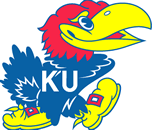
Kansas Jayhawks
|
Kansas Jayhawks Football History |
|||||||||
|
The School Colors
The University of Kansas colors, crimson and blue, used since the early
1890s, are not the colors originally adopted by the university Board of
Regents in the 1860s. The regents had decided to adopt the Michigan
colors, maize and sky blue.
Each spring, as the University of Kansas graduates a new class of
Jayhawks, the origin of its name comes into question. It's known that
the term, "Jayhawk", was used as early as 1849. In that year, a party of
pioneers crossing what is today Nebraska, called themselves "The
Jayhawkers of '49." They are believed to have taken the name from a
combination of two birds which are familiar in the West -- the hawk and
the blue jay. Whether these pioneers were the first to call themselves
Jayhawkers is not known. (later they did discover Death Valley in
California.)
One member of the party, John B. Colton, later remembered first hearing
the word in Platte River in 1849, long before the Kansas Territory was
established. Colton said when the Argonauts returned to the East, the
word continued to be used.
Dr. Charles R. (Doc) Jennison, a surgeon, used it in 1861 when he was
commissioned as a colonel by Kansas Gov. Charles Robinson and charged
with raising a regiment of calvary. Jennison called his regiment the
"Independent Mounted Kansas Jayhawkers," although it was officially the
First Kansas Cavalry and later the Seventh Kansas Regiment.
By 1866, the University of Kansas at Lawrence had adopted the mythical
bird as a part of the KU yell. By the mid 1890s, birds of one sort or
another were used to represent KU on postcards and wall posters - even
the university yearbook became known as the Jayhawker Yearbook.
George "Dumpy" Bowles, a student with the class of 1912, longed to make
a great contribution to KU spirit, but wasn't big enough to do historic
deeds on the athletic field. He turned to music and produced some
outstanding student musical shows. |
|||||||||
 as the athletic color in honor of Col. John J.
McCook, a Harvard man, who had given money for an athletic field at KU.
That field ran east and west in the proximity of where the north bowl of
Memorial Stadium stands on the Kansas campus today.
as the athletic color in honor of Col. John J.
McCook, a Harvard man, who had given money for an athletic field at KU.
That field ran east and west in the proximity of where the north bowl of
Memorial Stadium stands on the Kansas campus today.